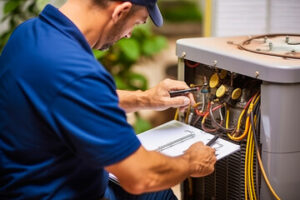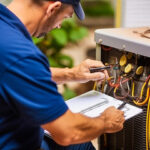Home » Posts tagged 'heating repair'
Tag Archives: heating repair
HVAC Systems and Ductwork
HVAC systems work to regulate the temperature of any building. They warm structures in the winter and cool them in the summer.
The most common types of hvac consist of split systems and packaged units. The former uses an indoor unit containing the evaporator coil and blower, while the latter uses a compressor. Visit https://www.taphvac.com/ to learn more.
 HVAC systems are essential for commercial and residential buildings, including single-family homes, apartment buildings, hospitals, and skyscrapers. They are used to keep indoor air comfortable and healthy for occupants. This means providing regulated temperatures, adequate ventilation, and filtration of pollutants, smoke, dust, odors, and other materials. HVAC systems also control humidity, making it easier to breathe in hot weather and colder weather.
HVAC systems are essential for commercial and residential buildings, including single-family homes, apartment buildings, hospitals, and skyscrapers. They are used to keep indoor air comfortable and healthy for occupants. This means providing regulated temperatures, adequate ventilation, and filtration of pollutants, smoke, dust, odors, and other materials. HVAC systems also control humidity, making it easier to breathe in hot weather and colder weather.
Heating systems in hvac generate heat to raise interior temperatures during the winter. They use gas furnaces, boilers, or heat pumps to do this. They may distribute warm air through radiators, underfloor heating, or ductwork, depending on the property and its layout. Many heating systems can also regulate the temperature of individual rooms or zones using a central system console.
In the summer, HVAC systems are used to cool a building. They use the same principles as air conditioners, but with different hardware. The evaporator coil in the furnace is filled with refrigerant that is at a low pressure. When the evaporator coil comes into contact with warmer, humid air, it changes from a liquid to a gas. The cooled air is then blown into living spaces through air ducts.
Ventilation systems in hvac include fans and filters to circulate and condition indoor air. They remove odors, smoke, heat, and other gases, and they reduce carbon dioxide levels to prevent deprivation of oxygen. They can also remove moisture, which helps with humidity control. They can also remove particulates, such as dust, dirt, mold spores, and pollen, from the air.
Most modern HVAC systems are highly efficient and can help a homeowner save on energy bills. This is due to improvements in technology and better understanding of how they work. For example, new thermostats have advanced settings that allow homeowners to monitor and control their energy usage. They can also minimize energy bills by focusing on keeping occupied rooms at the right temperature and avoiding wasteful cooling or heating of unoccupied spaces. The team at Galooli can help a home or business owner understand their energy needs and select the best systems for them.
Cooling
The cooling component of hvac systems works by removing heat and humidity from indoor air and expelling it outside. This happens via a system of coils filled with a substance called refrigerant. Cooling is accomplished through a variety of methods, including radiant, convection and conduction. Ultimately, all HVAC systems have one goal in mind: to create comfortable environments for the building’s occupants.
The evaporator coil in the furnace is a key component of your home’s cooling system. Housed within the furnace, it’s a small, circular piece of metal that absorbs heat from passing warm air and releases cooled air into your home through ductwork. While the evaporator coil is doing its work, a fan blows through the ducts to move the cooled air throughout your home.
Like the heating component, the cooling system also operates according to basic thermodynamic principles. The laws of thermodynamics state that heat can only travel in three ways: radiation, conduction and convection. Radiation is when heat transfers through light energy, such as sunlight. Conduction is when heat moves through solid materials, such as a pan being heated on a stove burner. And convection is when hot air rises and circulates throughout the room.
As for the cooling system, it is composed of a series of components that are linked together by copper tubing. This tube is a crucial link that allows the refrigerant to flow between an indoor unit and an outdoor unit. The evaporator coil in the air conditioner, housed inside the furnace, is a key component of the cooling system. It’s a circular piece of metal that, when exposed to air, becomes a liquid. The refrigerant is then changed back to a gas by changing its pressure. This process takes place over and over as the refrigerant moves between indoor and outdoor units.
Aside from the coils and ductwork, most cooling systems also use filters to keep indoor air clean. Regularly changing the filter can help prevent dust and debris from accumulating in the ducts, which can reduce airflow and lead to other issues. Additionally, a facility engineer should perform routine inspections of the equipment to identify any potential problems early on.
Ventilation
The ‘V’ in HVAC stands for ventilation, and it is one of the most important aspects of keeping a space comfortable and healthy. Ventilation allows fresh air to enter spaces and remove stale, stale-smelling air. It also helps to control humidity, temperature, odors, smoke, dust, mildew and bacteria in the air.
The air quality inside a home or business can be affected by a variety of factors, including the weather, the number of occupants and other outside pollutants. Proper ventilation is vital for regulating indoor air quality (IAQ), and it can reduce the risk of mold, mildew and other harmful substances in the air.
Ventilation is accomplished in a wide range of ways, from natural to mechanical. In the past, homes, schools and offices had easy access to the outdoors through doors and windows, but today’s tightly-sealed buildings require more efficient mechanical systems to bring in and exhaust stale air.
While there are many different types of ventilation systems on the market, all systems should be able to achieve the same basic goal: to move a sufficient amount of air into and out of the building to provide a fresh supply of outdoor air while removing stale, contaminated indoor air. This process should be carried out using a filtration system that can remove viruses, dust and other harmful particles from the air.
It’s possible to get a good idea of the ventilation needs of a building by having an evaluation conducted by an experienced professional. This will involve tools like blower door tests and air quality monitors to determine the rate of air flow needed for proper ventilation, based on a calculation of a building’s size, occupant numbers and local climate conditions. Alternatively, DIY evaluations can be conducted by monitoring the rate of airflow through vents and by using calculation guidelines provided by organizations like ASHRAE.
Ventilation is important for maintaining comfort, health and safety, as well as improving energy efficiency. It is essential to have all ventilation ducts unobstructed, and all openings should be clear of equipment and storage items that restrict airflow. In addition, a clean condenser unit will operate more efficiently and prevent excessive wear and tear on the system.
Ductwork
Ductwork is one of the most important parts of your HVAC system. Its job is to deliver conditioned air to each room in your home. Its quality significantly affects your comfort and energy costs. It also influences the overall performance of your hvac unit. If your ductwork is old, damaged, or inefficient, your HVAC system will struggle to perform optimally.
A well-designed duct system is essential to guarantee even temperature distribution throughout your home or building. Its size is determined by calculating the necessary airflow for each space it serves, and it must be properly placed to ensure good airflow. It must also be insulated and sealed to reduce heat loss.
Your ductwork contains two major components: the supply plenum and the return plenum. The supply plenum transports air to your rooms with air vents, while the return plenum takes air from the air vents back to your central HVAC system.
The primary type of ductwork used in homes is sheet metal ducts, which are made out of rust-resistant galvanized steel or aluminum. They are durable, easy to clean, and non-porous. However, they can develop leaks if their joints and seams aren’t correctly sealed. This is why it’s important to have your ductwork assessed and sealed regularly.
Another common problem with ductwork is static pressure, which refers to how much resistance the air faces when it circulates through the ducts. High static pressure can cause your blower to wear out prematurely and lead to poor indoor air quality. It can also force your heating system to work harder than necessary, which can increase energy costs.
Lastly, ducts can be blocked from airflow by furniture, boxes, and other items that are placed in front of the vents or registers. This can cause the air to cool or warm rapidly in that area and prevent proper ventilation. It is crucial that your ducts are properly sized and installed, and they should be regularly cleaned to eliminate dust, dirt, and allergens. Regular maintenance and insulation will improve the longevity of your ductwork.



